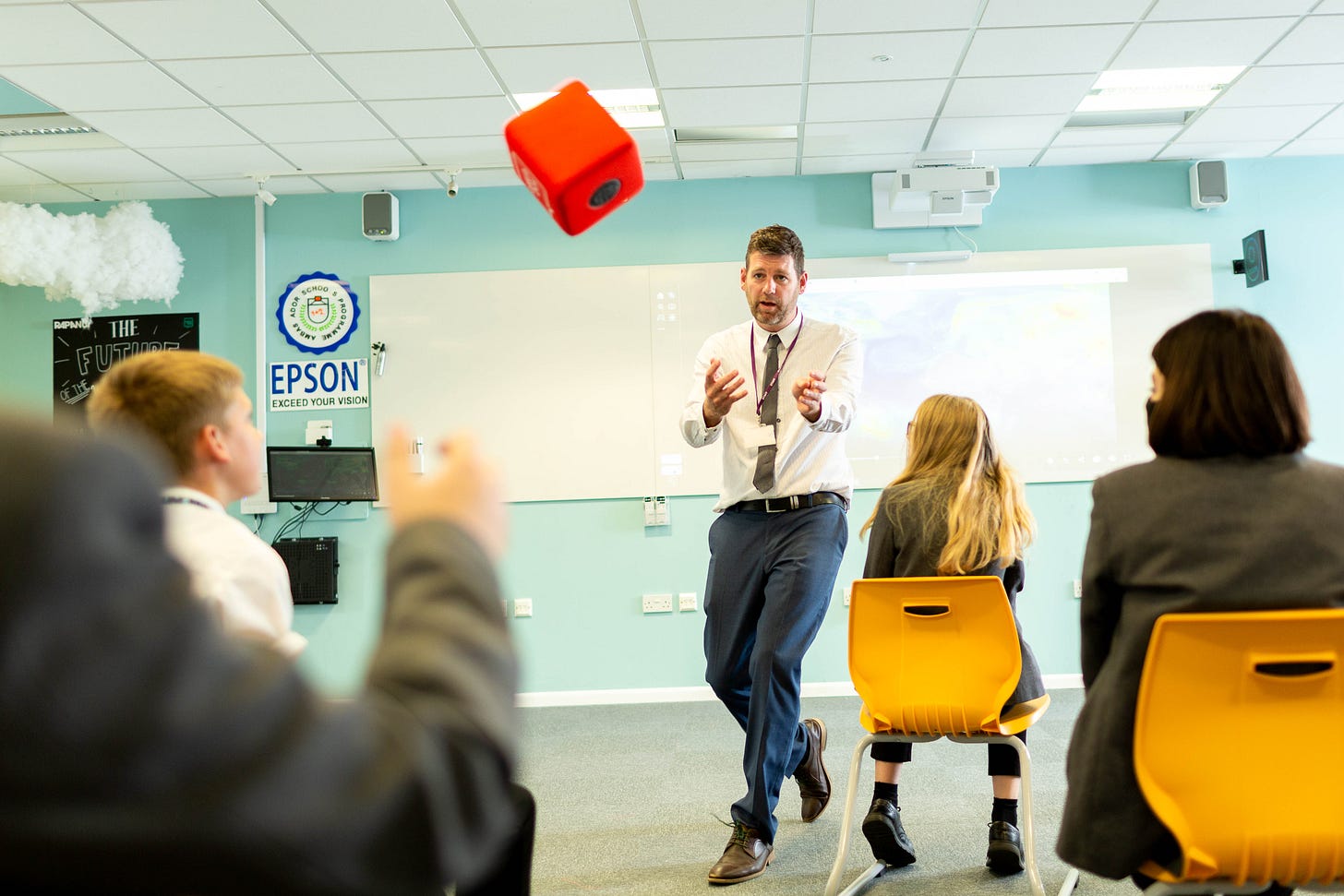Human beings were made to move, yet in the classrooms of today we see children increasingly rooted to their seats. Experts say children are sat down in class for an average of four hours a day. That’s a staggering 80 per cent of their school life - a fact that knocks me into ruins.
The act of learning is a wild category that we teachers have done our best to domesticate. The messy process of schooling has been streamlined since the pandemic with many schools adopting a similar approach to learning. For most children, an average day at school holds no curiosities.
A clear illustration of this is the way we arrange our classrooms. In the UK at least, people accept this as they do the weather. I visit many classrooms. There is an inevitable certainty to things. A set ‘way’ to do education. The rows of desks are as fixed as the room that holds them, angled forward, waiting for something to happen. And this is the point: little changes. The teacher occupies the front, carefully operating within a five-metre radius of the whiteboard.
The classroom is, and always has been the place where ideas and people meet. Post-COVID learning has defaulted to a safety position - one that sees children docile and inactive, and in my opinion distanced slightly from the learning. In this post, I argue that putting learning on its feet is a healthy way to shake up the learning and involve the students more actively in the process.
What are the benefits of putting learning on its feet?
There is a healthy body of research that supports the need for active learning in the classroom. If we are honest, the modern teacher often has to justify to others why they are reshaping their existing practices to try new ones. The high stakes testing, performance related pay and crushing content put strains on teacher creativity. Innovation then can be seen as a lonely act of defiance - but it doesn’t have to be. The benefits below make a convincing case for getting children active in lessons, even if this starts small and grows. Believe me once you embed movement in your lessons you will never look back and your students will thank you for it.
1 - Movement promotes focus and learning as it enhances brain functioning.
When you move, you stimulate all the nerve cells that you use to think with. Awakening those nerve cells increases concentration which in turn helps you focus and learn. Research by *John Ratey, an associate clinical Professor of psychiatry at Harvard University shows that when children activate their muscles in lessons, they turn on their attention systems. The benefits post-exercise, even if brief (20-30 seconds) includes increased attention spans and the ability to deal with more frustration.
2 - Children who move regularly in lessons do better in English and Maths.
This is an interesting development. A recent study by Alvarez-Beuno et al (2017) that involved 10,000 children between the ages of 4 and 13 found that physical activity in lessons not only improves behaviour, but it also boosts academic achievement. This particular study was orientated towards language and numeracy skills, but the findings hint at wider implications with crossovers into the humanities, sciences, and the creative disciplines. Movement allows children to recreate academic learning experiences through the creative faculties. For example, they can act out the journey of blood into the heart (Drama/Biology) or make up a rap song about volcanoes (Music/Geography). These are best achieved when children are out of their seats and active whilst being creative.
3 - Movement in the classroom can benefit behaviour and it uses up energy.
Research shows that children who are more active in lessons tend to exhibit better focus, memory recall and cognitive processing. There are also benefits linked to behaviour, particularly for children who have a diagnosis of dyspraxia or ADHD (Attention Deficiency Hyperactivity Disorder). Stimulating the senses and activating the muscles releases serotonin, a chemical that carries messages between nerve cells in the brain to every part of the body. Movement breaks in lessons breaks the cycle of sitting down, so when children do resettle, they are less likely to fidget or distract others.
4 - Physical literacy
In the ground-breaking book Physical Literacy: throughout the life course author Margaret Whitehead makes a convincing case for why education needs to embrace physical activity.
Firstly, there is the obvious acceptance of the physical as a literacy amongst other forms of academic literacies. Whitehead defines physical literacy as ‘the motivation, confidence, physical competence, understanding and knowledge that an individual develops in order to maintain physical activity at an appropriate level throughout their life.’
Research has shown us that children who value physical activity in their youth, tend to value it as adults. This helps them live a healthy lifestyle as they form habits early on. The same can be said about putting learning on its feet. When children leave school, they will find themselves an array of situations that require them to move. It might be standing to deliver a presentation to clients or guiding tourists up Mount Kilimanjaro. There are infinite opportunities that activity affords us, so why not embed it in our lessons?
Improved confidence is a direct benefit of physical literacy. Exploring new challenges and activities in lessons equips children with a boldness that affects other aspects of their life, particularly when incorporated with group work (see Chapter 6: Learning with others).
Physical literacy also increases coordination and reaction time meaning children will be more alert and responsive in lessons. Active lesson starters awaken the senses, fire up the synapses and increase productivity. I have witnessed this first hand as children raise their hand more often and respond quicker to instructions and questions when they have been active beforehand.
5 - Moving in lessons is good fun and children love it.
If the points above are not convincing enough, I hope this one helps. Children were designed to move. Increasingly, societal shifts towards gaming and personal devices see children inactive for long periods of time. The arrival of mobile phones and devices have rendered the children of today more docile, which is even more reason to shake up lessons a little to get them moving.
Children move less as they age. According to psychologist Jean Piaget, our thinking processes change radically, though slowly, from birth to maturity because we constantly strive to make sense of the world. Piaget (1970) identified four factors that interact to influence a child’s thinking as they mature: biological maturation, activity, social experiences, and equilibration. Two of these factors shine a light on why we should be creating opportunities for children to be active in lessons.
With biological maturation comes an increasing ability to act with and react to the environment we find ourselves in. Teachers often see this in effect in playground activity where children explore boundaries, social groups, and motor skills. As children explore, test, and observe, they eventually organise information that alters their thinking processes.
Moving could be the remedy post-pandemic classrooms need . . .
As we work to rebuild the fractured courage of our young people in a post-COVID world, we must be brave and try new practices in the classroom. The cynic might say that moving children around during the lesson causes disruption, and it does. But if we view disruption simply as a way to evolve then it becomes part of who we are as teachers and should not be hidden away.
There is a disparity at play between what school prepares our young people and the world beyond. You can read the substance of this argument in a thousand books. The world of work is rife with people who will tell you that our schools are failing to prepare our young people for the workforce. Teaching them to be active and agile, to pitch and present and be present in learning makes perfect sense. By putting learning on its feet, you are taking a step in the right direction and the children will follow you. Trust me, take the leap, you’ll land firmly on your feet.
In Part II we will explore the how, with some techniques and ideas designed for you to try.
Ideas in this post are taken from lessons in the Future Classroom, a leading innovation project based at Shaftesbury School, Dorset (UK).
For more information on the Future Classroom, visit the Hundred.Org Innovation page here:
References
Celia Álvarez-Bueno, MSc; Caterina Pesce, PhD; Iván Cavero-Redondo, MSc; Mairena Sánchez-López, PhD;
Miriam Garrido-Miguel, MSc; Vicente Martínez-Vizcaíno, PhD., 2017. Academic Achievement and Physical
Activity: A Meta-analysis. Pediatrics Journal. Vol. 160 (6)
Biggs, J, Collis, K & Edward, A., 2014. Evaluating the quality of learning: The SOLO Taxonomy. Original copy
1982 Academic Press Ltd
Eaton, J., 2022. EEF Blog: moving from ‘differentiation’ to ‘adaptive teaching’. EEF Online. Available at:
https://educationendowmentfoundation.org.uk/news/moving-from-differentiation-to-adaptive-teaching
Enser, Z., 2012. Full on Learning: Involve me and I’ll understand. Crown House Publishing
Piaget, J., 1970. Piaget’s theory. Handbook of Child Psychology. New York, Wiley
Sherrington, T., 2019. Rosneshine’s Principles in Action. John Catt Education
Wallace, K., 2018. Move over, ‘sit still’ Why kids need to move in school. CNN News online. Available at:
https://edition.cnn.com/2018/05/03/health/children-movement-schools-classroom/index.html
Whitehead, M., 2010. Physical Literacy: throughout the lifecourse. New York. Routledge
Woolfolk, A., 2014. Educational Psychology. Twelfth Edition. Pearson New International





